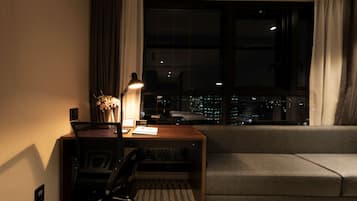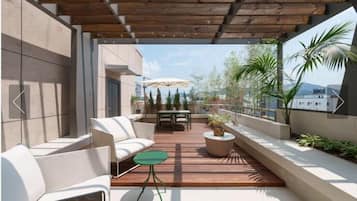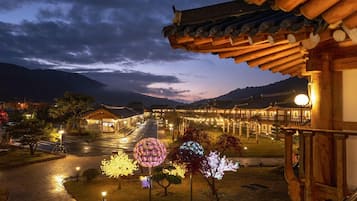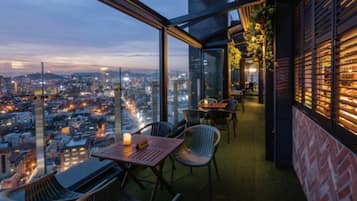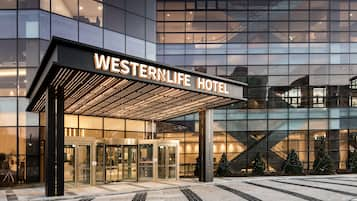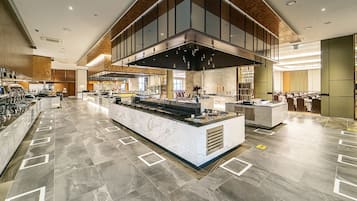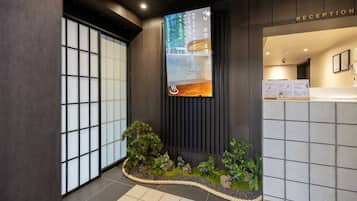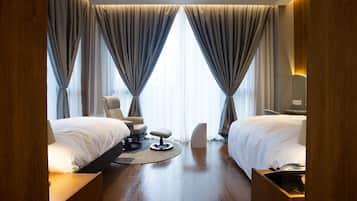Jeonju, the hometown of King Taejo Yi Seong-gye who founded Joseon, is home to particularly well-preserved landmarks with a deep history and traditional culture still maintaining the beauty of the country. When you enter Hanok Village located in the centre of the city, you will feel as if you have travelled back in time.
Gyeonggijeon Shrine is where the portrait of King Taejo Yi Seong-gye is enshrined and ancestral rites are held, so you can feel the sacred energy of the Joseon Dynasty here. Pungnammun Gate is a symbol of the city but also holds historical sorrows such as those from the execution of Catholic martyrs in the past. You can also visit various historical landmarks, from Jeonjuhyanggyo, which has been firmly standing in its place for hundreds of years serving Confucian saints and educating people about wisdom, to the Korea Traditional Culture Centre where the entire family can experience and enjoy traditional culture and games. Take a moment to set off on a journey back in time to Jeonju.
- 1
Jeonju Hanok Village
Traditional village full of stylish Hanok buildings

- Pároknak
- Családoknak
- Történelmi környezet
Jeonju Hanok Village is a place where hundreds of hanoks are gathered in the centre of the city. Here, you can appreciate traditional beauty in a special way. It is said that the village was established sometime in the 1930s when yangban groups formed a community in Pungnam-dong, Jeonju in response to the growing number and power of Japanese merchants and Japanese houses. Since the village was created in a relatively short period of about 100 years, it is characterised by “urban-style hanok,” different from hanok villages in other regions.
Above all, Jeonju Hanok Village is famous for its beautiful hanok roof lines harmonising with one another. You can feel elegance from the roofs facing the sky. You will be able to feel relaxed in the midst of scenery in which traditional and urban hanoks gather together and modern commercial facilities blend in naturally.
Elhelyezkedés: 99, Girin-daero, Wansan-gu, Jeonju-si, Jeollabuk-do, Republic of Korea
Telefonszám: +82 (0)63-282-1330
Térkép - 2
Pungnammun Gate
Fortress gate that protects the origin of the Joseon Dynasty

- Pároknak
- Családoknak
- Történelmi környezet
Pungnammun Gate is the only remaining gate among the four main gates of Jeonjubuseong, and the symbol of the city for the people of Jeonju. It has nearly the identical shape and characteristics as Sungnyemun Gate in Seoul, and it still preserves the form of the gate tower from the late Joseon Dynasty relatively well. The name, Pungnammun, means the gate to the south of Pungpae, or Feng Pei. Liu Bang, the Emperor of Gaozu of Han who successfully unified China, was born in an area named Feng Pei, and, similarly, Jeonju, the birthplace of Taejo Yi Seong-gye, was also considered as Feng Pei. Understanding this history of Pungpaejihyang, you will be able to appreciate Pungnammun in a more interesting way.
The gate has endured several misfortunes and ordeals including complete destruction by fire and reconstruction, but has kept its place. It was also used as a basecamp for the Donghak Peasant Army on their march to Jeonju and a site where Catholic martyrs were executed. As you can see, countless historical footprints make their mark over a single gate.
Elhelyezkedés: 1, Pungnammun 3-gil, Wansan-gu, Jeonju-si, Jeollabuk-do, Republic of Korea
Telefonszám: +82 (0)63-287-6008
Térkép - 3
Gyeonggijeon Shrine
Enshrines the portrait of Taejo, the founder of the Joseon Dynasty

- Pároknak
- Családoknak
- Történelmi környezet
Gyeonggijeon Shrine is a structure built to enshrine and perform ancestral rites for the portrait of King Taejo Yi Seong-gye, the founder of the Joseon Dynasty. The shrine holds great historical significance in that this is where the Jeonju Archive was installed. The name “Gyeonggijeon” means “the place where joy settled down,” which is quite fitting for the birthplace of the Jeonju Yi clan to which Yi Seong-gye belongs.
Gyeonggijeon consists of Hamabi Stele, which means that anyone on a horse should dismount since it is a sacred place, as well as Red Hongsalmun symbolising the entrance to a sacred site, Oesinmun and Naesinmun Gates and the Main Hall. The elegant Main Hall standing in the centre of the city and the thickly wooded trees surrounding the hall help you experience the distant history a bit closer. Spend some time in Gyeonggijeon Shrine to contemplate on the truth and wisdom that history conveys to us.
Elhelyezkedés: 44, Taejo-ro, Wansan-gu, Jeonju-si, Jeollabuk-do, Republic of Korea
Nyitvatartás: Daily from 9 am to 7 pm
Telefonszám: +82 (0)63-281-2788
Térkép - 4
Hanbyeokdang Pavilion
Petite pavilion where scholars shared their taste for the arts

- Pároknak
- Családoknak
- Történelmi környezet
Hanbyeokdang is a pavilion where poets visited to narrate poetry and share appreciation for the arts and travellers stopped by for brief rests. Here, you can feel the joy and chicness of scholars of the past. Built as a vacation home by Choe Dam who made great contributions to the founding of the Joseon Dynasty, the pavilion came to have the name, “Hanbyeokdang,” as the clear water flowing beneath it, crashing into rocks and dispersing like white jades looks ice cold.
The landscape surrounding Hanbyeokdang is so beautiful that it is considered one of the Eight Scenic Views of Jeonju. Once you reach this petite pavilion erected by carving out a cliff at the foot of Seungamsan Mountain, the scenery of green mountains and water flowing underneath awaits you. During summer, in particular, you will be able to get away from the heat and enjoy the charm of the pavilion under a cool shade. Feel the depth of the mood by checking out the poems narrated by scholars of those times who loved and appreciated the arts.
Elhelyezkedés: 2, Girin-daero, Wansan-gu, Jeonju-si, Jeollabuk-do, Republic of Korea
Térkép - 5
National Intangible Heritage Centre
Space that offers a peek into traditional culture and arts

- Pároknak
- Családoknak
- Történelmi környezet
The National Intangible Heritage Centre is a place that aims to organise, preserve and pass down intangible traditions and expressions from one person to the next, and boasts a variety of things to see and enjoy. Most people who visit Jeonju make their way to Hanok Village to check out Korean traditions and culture but you can also experience the unique culture in diverse ways at the National Intangible Heritage Centre.
The National Intangible Heritage Centre boasts quite a large scale. The centre features a facility capable of hosting permanent and planned exhibits as well as a theatre for performances and a building used for education and seminars. In the permanent exhibition hall, you will be able to enjoy videos of intangible culture in the fields of music and handicraft and also see colourful attire, accessories and items with your own eyes so it will be an interesting and visually pleasant experience.
Elhelyezkedés: 95, Seohak-ro, Wansan-gu, Jeonju-si, Jeollabuk-do, Republic of Korea
Nyitvatartás: Tuesday–Sunday from 9.30 am to 5.30 pm
Telefonszám: +82 (0)63-280-1400
TérképA kép készítője: Jinho Jung (CC BY-SA 2.0) módosítva
- 6
Jeondong Catholic Cathedral
Historical attraction boasting splendid architectural beauty

- Pároknak
- Családoknak
- Történelmi környezet
Jeondong Catholic Cathedral is the first Romanesque-style Roman Catholic church built in the Honam region. The beautiful architecture will leave you with a strong impression. It is said that Jeondong Catholic Cathedral was originally located where Catholics, including the first martyrs of Korea, were executed, but it was moved to its current location during the time of enlightenment. As many historical events such as the Donghak Peasant Revolution took place, the number of Catholics increased, and Jeondong Catholic Cathedral came to play a symbolic role as a holy place of Christianity in the Jeonju region.
Jeondong Catholic Cathedral is famous for its beautiful, magnificent and splendid buildings even among all Korean church structures. The granite used as the foundation stone of the cathedral came from the ramparts near Pungnammun Gate, which was destroyed during the Japanese colonial period, and some of the bricks of the main hall were also made by baking soil of those ramparts, which makes it all the more historical. Ruminate over history at the holy place of Christianity where the joys and sorrows of the people are still engraved.
Elhelyezkedés: 51, Taejo-ro, Wansan-gu, Jeonju-si, Jeollabuk-do, Republic of Korea
Nyitvatartás: Daily from 9 am to 6 pm
Telefonszám: +82 (0)63-284-3222
Térkép - 7
Omokdae Historic Site
Place where you can feel the footsteps of Taejo Yi Seong-gye

- Pároknak
- Családoknak
- Történelmi környezet
- Vásárlási lehetőségek
Omokdae Historic Site is where Taejo Yi Seong-gye, the founder of the Joseon Dynasty, held a feast on his way back from the victorious Hwangsan Battle against Japanese raiders. Today, it is well-known as a place from which the entire Jeonju Hanok Village can be seen in a single view. It is said that, during this feast, Yi Seong-gye became a bit overly excited after a few drinks and subtly expressed his ambition of founding a new country. Upon hearing this, Jeong Mong-ju rose up from the table and narrated a poem with a sorrowful, deploring heart at Mangyeongdae.
At Omokdae, there is a memorial stone and a monument house on which King Gojong's own handwriting is engraved. How heavy was the heart of the last emperor of the dynasty upon his visit to the place where the founder of that dynasty, Taejo, once stayed? Rise up to Omokdae and look at the tranquil scenery of Hanok Village filled with tile-roofed houses to feel the traces of the past history.
Elhelyezkedés: 55, Girin-daero, Wansan-gu, Jeonju-si, Jeollabuk-do, Republic of Korea
Telefonszám: +82 (0)63-232-2255
Térkép - 8
Jeonjuhyanggyo Local Confucian School
School of Confucian scholars firmly rooted for many centuries

- Pároknak
- Családoknak
- Történelmi környezet
Jeonjuhyanggyo is an educational institution of the Joseon Dynasty that is equivalent to today’s middle and high schools. Here, you can witness the cradle of character training that respects loyalty and filial piety. The storied Jeonjuhyanggyo has gone through numerous ups and downs over the course of 650 years but has firmly maintained its position to convey a culture that values loyalty and manners.
There are several ginkgo trees that are well over 400 years of age in Jeonjuhyanggyo. It is said that these ginkgo trees, which are typically not harmed by insects, were planted with the wish that Confucian scholars grow up in a healthy and upright manner like the trees. Every autumn when the tree leaves start to fall, many people visit to enjoy a fabulous view of ginkgo trees turning yellow. In summer, red flowers blossom on the crape-myrtle trees, which are planted throughout the area including the Daeseongjeon Shrine, to present another beautiful scene.
Elhelyezkedés: 139, Hyanggyo-gil, Wansan-gu, Jeonju-si, Jeollabuk-do, Republic of Korea
Nyitvatartás: Daily from 9 am to 6 pm
Telefonszám: +82 (0)63-288-4544
Térkép - 9
Korea Traditional Culture Centre
Facility where you can experience traditional culture and games

- Pároknak
- Családoknak
- Történelmi környezet
The Korea Traditional Culture Centre is a traditional culture facility filled with a variety of things to play with and enjoy and offers visual and physical experiences of traditional culture. At promotion hall, you can check out videos and illustrations of Jeonju’s history, culture and tourism and, also, view elements that symbolise Korea such as hanok, Korean food and hanji. In the food theme zone, you can check out an exhibit of stories about the local foods and seasonal dishes of Jeonju in addition to an actual cooking experience.
The Korea Traditional Culture Centre provides a first-hand experience of paper mulberry being made into hanji and fun traditional games that combine gugak and arts, which is why it is a perfect place to spend time with your family. It will be a special and meaningful experience for adults and children alike.
Elhelyezkedés: 20, Hyeonmu 1-gil, Wansan-gu, Jeonju-si, Jeollabuk-do, Republic of Korea
Nyitvatartás: Daily from 9 am to 10 pm
Telefonszám: +82 (0)63-281-1500
Térkép - 10
Chunggyeongsa Shrine
Shrine that pays respects to the spirits of a righteous army general
- Olcsó
- Történelmi környezet
Chunggyeongsa is a shrine built to pay respects to the achievements of Yi Jeong-ran, a righteous army general during the Japanese invasion of 1592. The temple is located on a tall mountain from which you can feel the determination from the time when the country resisted foreign invasion. Chunggyeonggong Yi Jeong-ran who had resigned from his government post assembled an army at the old age of 64 and protected Jeonjubuseong against the Japanese. During the Jeongyu War, he made such significant accomplishments that just rumours of him guarding Jeonju forced raiders to retreat. Chunggyeongsa honours the courage and loyalty of Chunggyeonggong.
In Chunggyeongsa, a Paljak-roofed shrine is seated on high ground at the rearest location underneath which there are Naesinmun, Oesinmun and Namgojae. From how the shrine calmly overlooks a steep mountain slope, you will be able to feel the patriotic and unyielding spirits of a general who courageously raised an army to protect his own country.
Elhelyezkedés: 31, Namgosanseong 1-gil, Wansan-gu, Jeonju-si, Jeollabuk-do, Republic of Korea
Telefonszám: +82 (0)63-281-2114
Térkép





